YOSEMITE CONSERVANCY
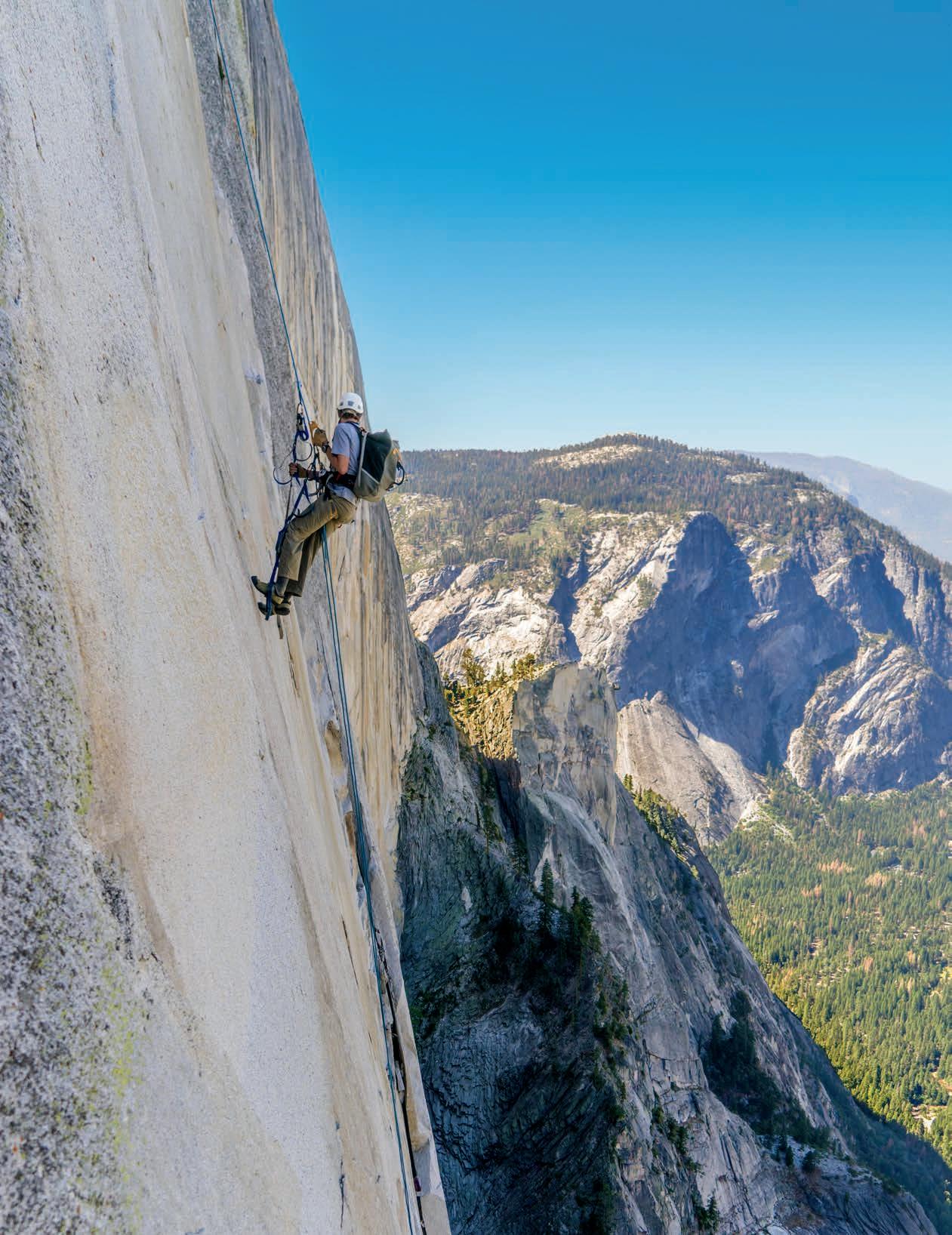
Exploring the Vertical Wild
What it Takes to Climb a Legendary Peak
Restoring Yosemite’s Trails
Expert Insights on Climbing Stewardship
Q&A with the Preventive Search and Rescue Supervisor
SPRING.SUMMER 2017 :: VOLUME 08.ISSUE 01
INSIDE
YOSEMITE CONSERVANCY COUNCIL MEMBERS
CHAIR
Bob Bennitt*
VICE CHAIR
Dana Dornsife*
COUNCIL
Hollis & Matt Adams*
Jeanne & Michael Adams
Gretchen Augustyn
Susan & Bill Baribault
Suzy & Bob Bennitt*
David Bowman & Gloria Miller
Tori & Bob Brant
Marilyn & Allan Brown
Steve & Diane Ciesinski*
Hal Cranston*
Carol & Manny Diaz
Leslie & John Dorman*
Dave* & Dana Dornsife*
Lisa & Craig Elliott
Jewell & Bob Engstrom
Kathy Fairbanks
Sandra & Bernard Fischbach
Cynthia & Bill Floyd*
Jim Freedman & Karine Joret
Susan & Don Fuhrer*
Bonnie Gregory
Rusty Gregory*
Karen & Steve Hanson
Laura Hattendorf & Andy Kau
Chuck & Christy Holloway
Christina Hurn & Richard Tassone
PRESIDENT & CEO
Frank Dean*
VICE PRESIDENT, CFO & COO
Jerry Edelbrock
Jennifer & Gregory Johnson
Jean Lane
Walt Lemmermann*
Melody & Bob Lind
Sam & Cindy Livermore
Anahita & Jim Lovelace
Mark Marion & Sheila Grether-Marion
Patsy & Tim Marshall
Kirsten & Dan Miks
Robyn & Joe Miller
Janet Napolitano
Dick Otter & Judy Wilbur
Sharon & Philip Pillsbury*
Bill Reller
Pam & Rod Rempt
Frankie & Skip Rhodes*
Liz & Royal Robbins
Dave Rossetti & Jan Avent*
Lisa & Greg Stanger*
Jennifer & Russ Stanton*
Ann & George Sundby
Clifford J. Walker*
Wally Wallner* & Jill Appenzeller
Jack Walston & Sue Estes
YOSEMITE NATIONAL PARK
Acting Superintendent Chip Jenkins
*Indicates Board of Trustees
OUR MISSION
Yosemite Conservancy inspires people to support projects and programs that preserve Yosemite and enrich the visitor experience.
PRESIDENT’S NOTE

Climbing Yosemite
irst-time visitors to Yosemite are often awestruck when they notice rockclimbers on El Capitan. That anyone could climb so high on such sheer cliffs is amazing.
Yosemite is inspiring, and it also brings out the explorer in all of us — such as the urge to see a waterfall up close or hike to the top of a dome to see the view. The skilled rock-climbers drawn to Yosemite are no exception; the sheer, clean granite walls are considered some of the best climbing in the world.
One of my favorite Conservancy-funded activities is our Ask a Climber program in El Capitan Meadow. Just look for the rangers in the meadow or by the bridge to answer your questions, and peer through their telescope at the climbers on the big wall.
In the following pages, you will find some insider tips on exploring Yosemite, including what it takes to climb a legendary Yosemite peak. There are also insights from rangers about vital programs funded by Conservancy donors, including Climbing Stewardship and Preventive Search and Rescue. Don’t miss the inspiring article on disabled climbing with my friend Mark Wellman, and consider signing up for one of our guided Outdoor Adventures hikes this season.
With Yosemite’s waterfalls at full volume this year, we encourage you to plan your trip for off-peak days to avoid the crowds, and look for some of our exciting new Yosemite books, including Celestial Yosemite, during your visit.
See you in the park!
Frank Dean, President
Connect with us online! Follow Yosemite Conservancy, and stay connected.
02 SPRING.SUMMER 2017 :: YOSEMITECONSERVANCY.ORG
COVER PHOTO Greg Stock, Yosemite’s park geologist, draws on his climbing skills to explore the sheer face of Half Dome.
PHOTO: (RIGHT) © KRISTAL LEONARD.
PHOTO: © COURTESY OF NPS.

CONTENTS
SPRING.SUMMER 2017 VOLUME 08.ISSUE 01
IN THIS ISSUE DEPARTMENTS

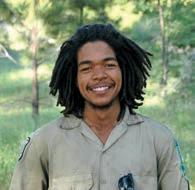

04 CLIMBING YOSEMITE’S ICONS
Curious about climbing? Read on for some basics on scaling Yosemite’s massive cliffs and peaks.
06 TRANSFORMING TRAILS AND LIVES
Youth in the California Conservation Corps restore Yosemite’s trails and discover their inner strength.
08
READING
THE ROCKS
Photos highlight some of our favorite lesser-known granite features and boulders in Yosemite.
10 EXPER T INSIGHTS
Climbing ranger Brandon Latham shares how Climbing Stewardship connects visitors to the park’s natural and cultural history.
12 Q&A WITH A YOSEMITE INSIDER
Keeping visitors safe with Preventive Search and Rescue: a conversation with supervisor Alan Hageman.
14 GRANT UPDATES
Restoring alpine meadows, connecting wheelchair-users with Yosemite, restoring wilderness and more.
18 PROGRAM UPDATES
Exploring Yosemite at your pace, packing tips for bear-proof canisters and enjoying luminous night skies.
22 THANKING OUR DONORS
Your generosity makes a difference in Yosemite.
28 WHY I GIVE
Conservancy donors share their stories of inspiration and passion.
30 READER PHOTOS
Yosemite Conservancy supporters share their special Yosemite memories.
YOSEMITECONSERVANCY.ORG :: SPRING.SUMMER 2017 03
ABOVE Lights hung by rock-climbers illuminate a path on Half Dome’s southwest side.

ICONS CLIMBING YOSEMITE’S
On the world-famous walls of a vertical wilderness
For some of the Conservancy team, climbing runs in the family. Cache, the 7-year-old son of El Portal-based staff member Adonia Ripple, hones his climbing skills on the granite walls near their Yosemite-area home.
osemite’s granite cliffs and peaks are legendary in the global climbing community. For those curious about climbing but not ready to rope up, Ask a Climber, a Conservancy-funded program, offers an enriching look at the vertical world. Stop by El Capitan Meadow this summer to ask your big-wall questions — and in the meantime, get a jumpstart on some key climbing topics.
WHAT’S THE HISTORY OF CLIMBING IN YOSEMITE?
In 1869, the year John Muir completed the first ascent of Cathedral Peak, California’s state geologist declared Half Dome “perfectly inaccessible”; six years later, George Anderson made it to the top.
In 1958, a team “topped out” on El Capitan (slang for climbed to the top), shattering its unattainable status during an era marked by innovation on the walls and tension with rangers on the ground. Today, the oncecontentious rapport has evolved into a collaborative relationship that respects the sport, while promoting safety and stewardship. Thanks to your support, climbers can volunteer as ambassadors and caretakers of the vertical environment through a Climbing Stewardship program, and as members of the park’s Search and Rescue team.
HOW DO YOU SCALE A CLIFF?
To start, do your homework. The Yosemite Decimal System

grades routes based on difficulty, from 5.0 (novice) to 5.15 (elite). Will you use devices for leverage (aid climbing) or rely on your own body for momentum (free climbing)? Are you heading out for a few hours or a few days?
Grab your gear, including specialized shoes, ropes, protective gear, harness and helmet. For multiday climbs, bring bags to hold your supplies (and your waste), plus a portaledge to sleep on.
Ready to “send” your route? Pick your starting roles: Partner 1 carries the rope up, securing it at anchor points along the way; Partner 2 controls the slack from the ground, feeding it through a belay device. Once the lead reaches a ledge, the roles switch: Partner 2 climbs, collecting the anchoring equipment, as Partner 1 belays from above. When the partners meet on the ledge, you’ve completed one pitch.
Work upward, pitch by pitch, until you “top out.” Enjoy the view and the satisfaction, and then rappel or hike back to earth.
HOW DO CLIMBERS CARE FOR THE VERTICAL ENVIRONMENT?
While the Valley itself is not federal Wilderness, its granite walls received that designation in 1984. Within that vertical Wilderness, vibrant ecosystems thrive. Plants and tree frogs peek out from cracks. Peregrine falcons nest on ledges, their presence a reminder of successful efforts, made possible in part by Conservancy grants, to reintroduce and protect a species that teetered on the edge of extinction. continued on p. 26
ROYAL ROBBINS, a pioneer in Yosemite’s climbing community and a member of the Conservancy’s Council, passed away in March 2017 at the age of 82.
In the words of Bob Bennitt, our current board chair: “In the view of many, Royal was the most important climber of his era. His leadership of the clean climbing movement transformed and improved the world of climbing forever. To me, Royal was even bigger than all of his many accomplishments on the great walls of Yosemite. He was real, and down to earth, sincere and honest, warm, caring, and genuinely interested and curious. I think I will remember his resonant voice and ready smile most of all.”
The Conservancy family is ever grateful for Royal’s loyalty and generosity.
YOSEMITECONSERVANCY.ORG :: SPRING.SUMMER 2017 05
PHOTO: (LEFT) © ANDREW “BOOTS” DAVENPORT. PHOTO: © TOM FROST, COURTESY OF ROYAL ROBBINS, LLC.
Robbins on the Salathé Wall, 1961.

TRANSFORMING TRAILS AND LIVES
Young adults grow through a season in Yosemite
or nearly two decades, Conservancy donors have supported the California Conservation Corps (CCC) trails program, enabling hundreds of young adults to experience and restore Yosemite’s incomparable wilderness. The park’s CCC crews have completed thousands of miles of trail work throughout the years; in 2017, they expect to add 128 miles to that total.
Yosemite’s CCC trail season starts in early spring. Participants, who range in age from 18 to 25, begin with a month of trail repair basics in the Valley and Hetch Hetchy, before striking out for the backcountry. This year, one group heads north to the Tuolumne watershed; the other steers south to the Merced. During the next five months, they will hone tangible skills, taking tips from
06 SPRING.SUMMER 2017 :: YOSEMITECONSERVANCY.ORG
ABOVE During their season in Yosemite, California Conservation Corps participants connect with the wilderness while restoring and exploring trails around places such as Smith Peak.
“Nothing else instills self-improvement and environmental values with the same effectiveness.”
— 2016 PARTICIPANT
California Conservation Corps (CCC)
resident experts, as they split and move boulders, build stone walls (held together by physics, not cement), and fill ruts forged by feet and flowing water.
Their work benefits hikers and natural resources. High-quality trails encourage people to stay on delineated paths, preventing the vegetation loss, soil compaction and other damage caused when humans trample fragile terrain. Drainage features prevent erosion and protect water quality, ensuring healthy habitat for plants and animals downstream. Yosemite crews use nonasphalt, regionally sourced surface material, providing a sustainable alternative to less permeable tread that can be repurposed as needed.
Five months in Yosemite’s backcountry also can have a profoundly positive effect on the participants, themselves. A season of restoring wilderness trails, coupled with evening classes and weekend adventures, helps instill a strong awareness of the value of public lands and the impact humans have on nature. Working with a team in a physically and mentally challenging environment nurtures collaboration, communication and fresh perspectives. More than 90 percent of 2016 participants surveyed said the program had changed their lives in a positive way, and they’d learned more about themselves and about getting along with others.
“I learned how to approach challenges with a can-do attitude,” a 2016 participant wrote, adding this assessment of the program: “Nothing else instills self-improvement and environmental values with the same effectiveness.”
The next time you’re hiking in the backcountry, remember this: Embedded in the steps and water bars are the stories of young adults who took a chance on a season in Yosemite and emerged with new skills, a new outlook and a new understanding of the importance of protected lands — thanks to your support.
Learn more about the CCC crews and their experience restoring — and being restored by — Yosemite’s backcountry in this blog post: yosemiteconservancy.org/ccc.




Before and after images capture one CCC member’s transformation from, in her words, “nervous” to “accomplished.” See more: yosemiteconservancy.org/ccc.
YOSEMITECONSERVANCY.ORG :: SPRING.SUMMER 2017 07
A CCC member splits wood at base camp in Foresta. Crews start out working on trails in more developed parts of the park before heading to the backcountry.
As part of their Yosemite experience, CCC participants learn key trail restoration techniques, such as how to split and shape rocks.
PHOTOS: (LEFT) © COURTESY OF NPS. (TOP RIGHT) © YOSEMITE CONSERVANCY. (MIDDLE RIGHT) © COURTESY OF NPS. (BOTTOM RIGHT) © YOSEMITE CONSERVANCY.

Reading the Rocks
IMAGES OF A FEW OF OUR FAVORITE YOSEMITE STONES
osemite’s official designation as a national park goes back only 127 years, but many of the features that first inspired that protection have been around for millennia. From soaring peaks that draw our gaze everupward, to boulders dotting polished granite slopes, geologic features tell powerful stories of the natural forces and human lives that have shaped the park. Icons such as Half Dome and El Capitan offer a fascinating — and much-studied — window into Yosemite’s past, but we’re going beyond the classics to highlight a few lesser-known features.

 Leaning Tower
Leaning Tower
08 SPRING.SUMMER 2017 :: YOSEMITECONSERVANCY.ORG
Mirror Lake

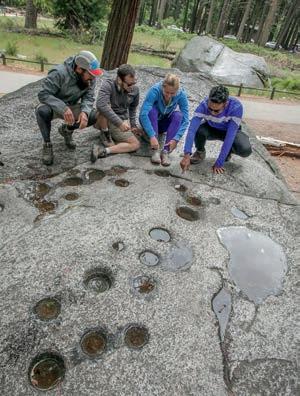


MIRROR LAKE
This small rock in the shallow, seasonal waters of Mirror Lake drew Yosemite photographer George Fiske’s eye in the 1880s and remains a popular camera subject (and balancing spot) today.
OLMSTED POINT
At Olmsted Point, visitors admire Half Dome while climbing on erratics. These boulders, distinct from surrounding rock, were carried by ancient glaciers and deposited when the ice melted.
LEANING TOWER
The Leaning Tower, which forms the right (western) flank of Bridalveil Fall, is a popular destination for Yosemite climbers looking to tackle their first big wall.
POUNDING ROCKS
For generations, American Indians living in Yosemite used pestles and pounding rocks to process acorns and berries — dietary staples. The mortar cavities are still visible on boulders in the Valley.
MT. HOFFMANN
Mt. Hoffmann, named for an early Sierra Nevada cartographer, rises high above May Lake at the park’s geographic center, offering panoramic views and prime marmot habitat.
MATTHES CREST
Today, the serrated, mile-long Matthes Crest is a popular Cathedral Range traverse for skilled climbers; during Yosemite’s glacial days, the craggy ridge was a nunatak (island) rising above the ice.
Olmsted Point
Matthes Crest
Mt. Hoffmann
PHOTOS: (Mirror Lake) © GEORGE FISKE (1880 s). (O lmsted Point) © KEITH WALKLET. (Leaning Tower) © CAROLYN BOTELL. (Pounding Rocks) © KEITH WALKLET. (Mt. Hoffmann) © JON SULLIVAN (PD PHOTO.ORG). (Matthes Crest) © ALICIA MARTINEZ.
Pounding Rocks

LEFT Yosemite’s Climbing Stewardship team helps keep the walls pristine; here, a ranger cuts leftover rope from a route in the Valley. MIDDLE Park staff, interns and volunteers work together to improve access to popular climbing routes, such as this approach trail to Washington Column.

CLIMBING STEWARDSHIP PROGRAM
EDUCATION AND CONSERVATION ON AND OFF THE GROUND
BY BRANDON LATHAM, CLIMBING RANGER, YOSEMITE NATIONAL PARK
osemite’s official Climbing Stewardship program launched in 2012, but the idea behind it — forging ties between climbers and the National Park Service (NPS) to benefit people and the park — is decades old. Wayne Merry, part of the trio that completed the first El Capitan ascent in 1958, used his dual role as a climber and ranger to strengthen park–climber relationships, and helped establish the volunteer Search and Rescue program that launched my own NPS career.
Today, the links Merry and other early, unofficial climbing rangers forged anchor the stewardship program, which has grown from a grassroots initiative into a professional operation focused on education and environmental protection. Conservancy grants have propelled the program’s evolution, in part by helping us engage talented volunteers to amplify our efforts.
Our climbing volunteers come from all over the country and all stages of life, but they are united by shared passions for Yosemite, climbing and conservation. From
10 SPRING.SUMMER 2017 :: YOSEMITECONSERVANCY.ORG
EXPERT INSIGHTS

May through October, they pour that passion into outreach and stewardship. A typical day might start with an El Capitan visit, to talk to climbers and clean up accidentally dropped gear or trash, followed by an afternoon running “Ask a Climber,” the Conservancy-funded program in El Capitan Meadow that draws thousands of visitors — including climbers who wander over from Camp 4 to pose questions or peer through the telescopes. Face-to-face time helps reinforce the program’s credibility within the climbing community. We’re not sitting at a desk writing policies; we’re outside and on the walls, sharing important information and listening to their concerns.
Volunteers also support emergency operations, host “Climber Coffee” gatherings and help address one of the biggest concerns we hear from climbers: confusing networks of user-generated approach paths at popular routes. Thanks to Conservancy support, we have been addressing that issue by creating well-delineated, sustainable access trails.
Despite its name, the Climbing Stewardship program extends far beyond rock walls. Many principles we share apply to the horizontal wilderness, such as tips for staying safe, managing waste or using designated trails. From an education standpoint, climbing is a great vehicle for teaching all visitors about the geology, ecology and history of Yosemite’s world-famous landscape.
Thanks to you, Yosemite’s Climbing Stewardship program is growing stronger every year and has inspired similar initiatives in other parks. As you read this, our 2017 volunteers are embarking on another season of educating visitors, restoring trails and, of course, climbing. Stop by El Capitan Meadow, and ask them a question!

PROJECT SUMMARY
Climbing stewards began in 2012 as a grassroots program to supplement the small number of climbing rangers and address the growing need for habitat preservation in Yosemite’s climbing areas. Thanks to Conservancy donors, grants to the “Ask a Climber” program and to repair climbing trails have provided critical support. This year, direct funding of the Climbing Stewardship program allows climbing rangers to increase the depth and breadth of their work. Thanks to your support, the program not only builds local stewardship, but reaches out beyond Yosemite, working with industry partners and climbing organizations to grow a culture of collaborative caretaking of our public lands.

BRANDON LATHAM is a climbing ranger in Yosemite. He started out as a climber exploring routes in Colorado, including in Rocky Mountain National Park. An internship in Yosemite led Latham to volunteer with the Yosemite Search and Rescue team for seven seasons. He learned about formalized climbing management while working for the climbing program in Denali. With this experience, Latham returned to Yosemite in 2014 as a climbing ranger and helped lead the development of the Climbing Stewardship program. This season, he’s handing over the reins of the climbing program and returning to his roots in Search and Rescue.
YOSEMITECONSERVANCY.ORG :: SPRING.SUMMER 2017 11
EXPERT INSIGHTS
PHOTOS: (TOP LEFT, MIDDLE & RIGHT) © COURTESY OF NPS. (BOTTOM RIGHT) © AL GOLUB.
“Because
of Yosemite Conservancy,
PSAR is a vibrant and successful program.”
— ALAN A. HAGEMAN Preventive Search & Rescue Operations Supervisor
Q&A
WITH A YOSEMITE INSIDER

ver since Alan Hageman joined the U.S. Coast Guard at 18, he has been involved in some form of public safety. In his previous post, he worked as the safety officer and interpreter at the George Washington Birthplace National Monument. Off-hours, he was active on a community-based volunteer rescue squad. When an opening came up in Yosemite for supervisor of Preventive Search and Rescue (PSAR) operations, Hageman was drawn to the challenge. Joining the team in 2015, he found it was the perfect blend of his experience in public safety and education, set in the unparalleled scenery of Yosemite.
Q :: What do you love about working in Yosemite National Park?
A :: I enjoy the privilege of working and living here. It’s so meaningful to know I play a small part in reducing emergencies and helping visitors develop pleasant memories of Yosemite.
Q :: Please explain what Preventive Search and Rescue volunteers do.
A :: Other than my position, PSAR is entirely volunteer-
staffed. Our volunteers educate visitors about having a safe and enjoyable experience on Yosemite’s trails.
Once an emergency occurs, law-enforcement park rangers and support teams are called in for a Search and Rescue (SAR). Depending on their skill set, PSAR volunteers actively train with and participate, as needed, in emergency service calls.
Q :: How has the PSAR program made a difference in Yosemite?
A :: Yosemite’s visitation has steadily increased, but we have been able to reduce the rate of SARs from 7.20 per 100,000 visitors in the 2009 peak season to 5.21 during the same period in 2016.
One key area is the Mist Trail corridor. It’s our busiest trail for hikers and SAR activity, especially the slick steps below Vernal Fall. By encouraging hikers to use the Clark Point cutoff, PSAR volunteers have seen Mist Trail incidents fall from the usual rate of 50 per year to only 27 in 2016. We’d like to see such success throughout Yosemite.
Q :: What are your suggestions for a safe Yosemite visit?
A :: Planning is vital. Before you head out on a hike, ask yourself: How long and steep is the route? How much food and water should I bring? Are there any hazards or difficulties? What is the weather forecast?
12 SPRING.SUMMER 2017 :: YOSEMITECONSERVANCY.ORG
As supervisor of Yosemite’s Preventive Search and Rescue program, ranger Alan Hageman focuses on educating visitors about staying safe in the park.
Stay on the trail and away from moving or white water. In almost all the most serious injuries, someone made a spontaneous off-trail trip and got lost, found themselves in swift water or took a bad fall. Granite is slippery, even when dry.
Tell a friend your plans before you go. Snack regularly on salty foods to replace minerals lost from sweat. And, finally, stay hydrated! Drink one liter of water for every two to three hours of activity.
Q :: How do Conservancy donors help keep visitors safe?
A :: Our dedicated intern volunteers provide direct services to visitors, and they help me recruit, train and support the other volunteers. Conservancy funding provides crucial supplies for these interns, including lodging, a food allowance, uniforms and equipment. Because of Yosemite Conversancy, PSAR is a vibrant and successful program.



Shop now at yosemiteconservancy.org YOSEMITECONSERVANCY.ORG :: SPRING.SUMMER 2017 13 YOSEMITE INSIDER
PHOTOS: © COURTESY OF NPS. Explore a New Perspective. Delight in a Fresh Narrative. Remember Your Favorite Place. Yosemite Conservancy Publications, 2017.
ABOVE In addition to educating visitors, PSAR volunteers help with emergency operations, such as this carry-out on the Four Mile Trail. RIGHT PSAR volunteers — easy to spot in their yellow shirts — work closely with Hageman (center) to keep people safe in Yosemite.
New Grants for 2017*
TRAIL
REHABILITATION & ACCESS
Building Historic Connections: Washburn Trail
$295,055
CCC Crews Restore Trails: Merced River Watershed $200,056
CCC Crews Restore Trails: Tuolumne River Watershed
Restore the Bridalveil Fall Area
WILDLIFE MANAGEMENT
Keep Bear Cubs Safe with GPS Tracking
Protect Yosemite’s Owls
Restore Rare Frogs and Turtles
Return Bighorn Sheep to the Heart of Yosemite’s Wilderness
HABITAT RESTORATION
Improve John Muir Trail and Meadow Habitat in Lyell Canyon
$200,056
$292,900
$13,500
$97,587
$217,301
$87,832
PROTECTING MOUNTAIN MEADOWS
STOPPING THE SPREAD OF INVASIVE PLANTS
IN THE HIGH SIERRA
$165,210
Keep It Wild: Restore Yosemite’s Wilderness $188,315 Plant Flowers to Save Pollinators
Protect Alpine Meadows from Invasive Plants
SCIENTIFIC RESEARCH
Discover and Document Ackerson Meadow Species
Protect Songbirds and Inspire Visitors
Streaming Science: The Yosemite Bat Channel
Yosemite Valley Predators: Raccoons, Ravens & River Otters
CULTURAL & HISTORIC PRESERVATION
$70,430
$43,640
$47,562
$52,000
$30,748
$42,750
Build a Traditional Roundhouse at Wahhoga Village $54,838
Preserve Yosemite’s Horse and Mule Tradition $7,000
Restore Historic Scenery: Valley View
$44,060 Traditions to Careers: Engage Tribal Youth in Archeology
$10,000 Yosemite Goes Global: Connect with International Parks
VISITOR SERVICES & EDUCATION
Adventure Risk Challenge: Youth Build Skills in Yosemite
Ask a Climber
Inspire New Stewards at UC Merced
Junior Ranger Programs
Keep Visitors Safe with Preventive Search and Rescue
No Limits: Yosemite Adventures for Wheelchair Users
Parks in Focus: Youth Explore Nature through Photography
Parsons Memorial Lodge Summer Series
Replace Search and Rescue Tent Housing
WildLink: Teens Connect to the Natural World
Yosemite Climbing Stewardship Program
Yosemite Leadership Program: Summer Internships
Yosemite Nature Notes Series
$15,000

$85,000
$49,000
$105,300
$125,000
$50,000
$21,460
$24,000
$30,000
$14,682
$50,000
$71,850
$90,000
$60,000
TOTAL $2,952,132
*Color represents 2016 Youth in Yosemite Programs.
ar above sea level in Yosemite, the air thins, temperatures drop, and high-elevation habitats thrive. Snow-fed alpine meadows support a remarkable array of plants and animals.
Invasive plants disrupt these havens of biodiversity. If allowed to spread, such plants can transform meadows into monocultures, eliminate animal habitat and weaken ecological resilience to climate change.
With support from Conservancy donors, park crews have surveyed more than 17,250 acres for invasive plants in recent years, often focusing above 7,000 feet. Along the way, crews map and remove non-native flora; this year, they will treat another 50 acres of invasive alpine plants.
GRANT UPDATES
14 SPRING.SUMMER 2017 :: YOSEMITECONSERVANCY.ORG

The fieldwork pays off — 2016 results show that 25 invasive species potentially have been eradicated from high-elevation areas — but the full benefits cannot be measured in acres. By giving interns and volunteers hands-on habitat restoration experience, this project is cultivating new crops of environmentally engaged stewards.
With support from Conservancy donors, park crews have surveyed more than 17,250 acres for invasive plants in recent years, often focusing above 7,000 feet.

Thanks to you, park staff and volunteers are continuing to document and treat existing populations of invasive plants this year. Meanwhile, we can all help prevent new ones from taking root, by staying on trails and brushing off hiking gear to avoid accidentally transporting non-native seeds.
As Student Conservation Association intern Richard realized while unearthing dandelions last summer, small acts, from pulling plants to cleaning boots, add up: “As the climate warms, alpine regions are put at greater risk for the spread of invasive species ... On the small scale, we were weeding. On a larger scale, I saw everything that was at stake.”
LEFT Volunteers play an important role in Yosemite’s efforts to identify and remove invasive plants that pose a threat to ecosystem health.
RIGHT By supporting invasive plant management in the park, your gifts help protect habitat for native wildflowers, such as shooting stars.
GRANT UPDATES
PHOTOS: (ABOVE) © COURTESY OF NPS. (RIGHT) © ANNE SANDMAN.
YOSEMITECONSERVANCY.ORG :: SPRING.SUMMER 2017 15
EXPANDING ACCESS TO ADVENTURES
NEW YOSEMITE PROGRAM FOR VISITORS WITH PHYSICAL CHALLENGES

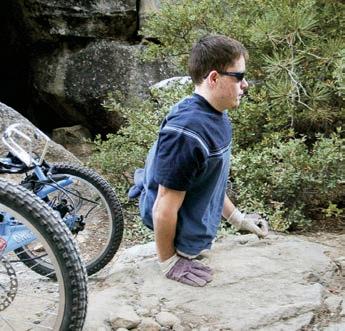
ore than 30 years ago, a climbing accident in the John Muir Wilderness left mountaineer Mark Wellman paralyzed from the waist down. Rather than dampening his passion for exploring the natural world, the event pushed Mark to embrace a “no limits” philosophy. He made the first paraplegic ascents of El Capitan and Half Dome, sit-skied across the Sierra Nevada, and served as an interpretive ranger in Yosemite.
This year, Mark is bringing his enthusiasm for envelope-pushing adventures back to the park. The No Limits Yosemite program helps wheelchair-users experience the natural world beyond the traditional confines of paved paths, leveraging adaptive equipment to help them explore vertical granite walls and wilderness areas. Thanks to your support, Mark and his team are empowering participants to go beyond perceived boundaries in outdoor recreation, and become active, informed users — and stewards — of our public lands.
16 SPRING.SUMMER 2017 :: YOSEMITECONSERVANCY.ORG GRANT UPDATES
Pioneering climber Mark Wellman, pictured here at Glacier Point, is encouraging wheelchairusers to discover Yosemite with “no limits” this year.
PHOTOS: © MARK WELLMAN. PHOTOS: (TOP) © TED HUNTING. (BOTTOM) © COURTESY OF NPS.
No Limits program participants will explore the park through adaptive climbing and hand-pedaled cycling.
RESTORING WILDERNESS
GRANT-FUNDED CREWS KEEP THE PARK’S BACKCOUNTRY WILD

he 704,624-acre Yosemite Wilderness serves as a permanent home for diverse plants and animals—and as temporary habitat for tens of thousands of visitors. Those hikers and backpackers inevitably, and often inadvertently, leave a mark on the landscape, by dropping food wrappers, transporting non-native seeds, or camping too close to water.
For nearly three decades, our donors have funded wilderness restoration in Yosemite. In 2016, with your support, park staff worked with a Student Conservation Association crew, Conservancy volunteers and other groups to survey 8,178 wilderness acres, eliminate or formalize more than 600 campsites, remove invasive plants and fire rings, and restore social trails.
Everyone who cherishes wilderness has a role to play in keeping Yosemite wild. As your gifts propel another season of restoration this year, take simple steps to minimize your own impact: camp and cook at least 100 feet from water, and leave nothing but carefully placed footprints behind.

A 35-day Student Conservation Association
“Keep It Wild” crew removed or maintained more than 208 backcountry campsites last summer.
Ready to explore – and protect –Yosemite’s backcountry?
Join one of our casual backpacking trips this summer to adventure through stunning wilderness areas and learn to “leave no trace” with a naturalist guide.
yosemiteconservancy.org/ outdoor-adventures
YOSEMITECONSERVANCY.ORG :: SPRING.SUMMER 2017 17 GRANT UPDATES
During the 2016 season, restoration staff and volunteers covered 220 miles on foot to restore wilderness destinations such as Lyell Canyon.
YOSEMITE AT YOUR PACE


LEFT On beginner-friendly trips, Outdoor Adventures participants build backpacking skills and explore less-visited parts of the park in a relaxed environment. MIDDLE Explore at an unhurried pace — and take breaks to enjoy quiet moments with epic views — during casual, expert-led adventures
ow old are these mountains? What does a great gray owl sound like? How did the early Miwok people prepare acorns for food? Satisfy your curiosity on a Yosemite Conservancy Outdoor Adventure with park scientists, researchers and expert naturalist guides. Our team has an array of fresh offerings to help you cultivate a deeper understanding of your favorite park.
The Conservancy’s new Dine and Discover ™ series includes an al fresco picnic and opportunity to hear behind-the-scenes information from insiders who have spent years studying the
18 SPRING.SUMMER 2017 :: YOSEMITECONSERVANCY.ORG PROGRAM UPDATES
CONNECT
ADVENTURE
TO YOUR PARK ON A RELAXED

natural and cultural history of the park. Gain closer insights to the grants made possible by your support, including wildlife management, habitat restoration and more.
Looking for a low-stress trek into the backcountry? Casual backpacking trips enjoy a leisurely pace to a lovely alpine setting. Expert naturalist guides will make the trail come alive, as they enrich your hike with stories of the area. These trips are great for both beginning and experienced backpackers looking for a relaxed outing to the High Sierra.
Yosemite offers a lifetime of exploration and learning. Tune in to the park in a new way by exploring with Yosemite Conservancy.

JUNE 2–3
Dine and Discover: Geology Underfoot
JUNE 9–11
Introduction to Backpacking: Hetch Hetchy
JUNE 24–25
All Angles of Angling: Fly Fishing and Aquatic Life — Trip 1
JULY 14–16
Casual Backpacking: Ostrander Lake
AUGUST 17–20
Casual Backpacking: Polly Dome Lakes
SEPTEMBER 14–17
Casual Backpacking: Mono Pass
SEPTEMBER 30–OCTOBER 1
Dine and Discover: American-Indian Food Preparation and Acorns
Check out a full list of this year’s programs at yosemiteconservancy.org/ outdoor-adventures.
Want something specific? Let Yosemite Conservancy organize a Custom Adventure for you.
YOSEMITECONSERVANCY.ORG :: SPRING.SUMMER 2017 19 PROGRAM UPDATES
2017 OUTDOOR ADVENTURES HIGHLIGHTS
Find your next adventure.
PHOTOS: (LEFT) © MATT MCIVOR. (MIDDLE) © RYAN KELLY. (RIGHT) © KEITH WALKLET.
PACK IT IN, PACK IT OUT


lanning a backpacking trip in Yosemite? Use a bear-proof canister to ensure your food and scented items remain inaccessible to curious bears. Laurie Stowe has run Yosemite Conservancy’s wilderness programs for the past 19 years and has backpacked most trails in Yosemite. Here are her tips on how best to pack a canister:
• Remove bulky food packaging. Utilize small, compressible bags for each meal. Remember to include any cooking instructions from original packaging.
• Canisters will be tossed around in a backpack. Pack them tightly, so objects won’t rattle around inside. Fill empty space in the canister with other gear.
• Choose foods that are dense in calories and nutrition, and that are compactable, such as tortillas.
• Toiletries, first-aid kits and other scented items need to fit into a canister at night.
Rent a bear-proof canister from Yosemite Conservancy staff, located at all park wilderness permit locations — proceeds go back to the park! Seasonal hours can be found at nps.gov/yose/planyourvisit/permitstations.htm.
20 SPRING.SUMMER 2017 :: YOSEMITECONSERVANCY.ORG PROGRAM UPDATES
By renting out bear-proof canisters, the Conservancy’s Wilderness team helps visitors protect wildlife and collects fees that support the park.
Bear-proof canisters offer a simple way to make a big difference for Yosemite wildlife.
PHOTOS: (TOP) © KEITH WALKLET. (BOTTOM) © YOSEMITE CONSERVANCY. PHOTO: © KRISTAL LEONARD.
TIPS ON PACKING YOUR BEAR-PROOF CANISTER
CELESTIAL YOSEMITE



To purchase, visit one of our bookstores in Yosemite, or shop online at yosemiteconservancy.org/shop.
iscover the wonders of luminescent Yosemite nights through the lens of astro-photographer Kristal Leonard in her new book, Celestial Yosemite. Leonard’s work depicts the mesmerizing power of the night sky and the primal connection we share with our ancestors when gazing into the untrammeled darkness.
Through vibrant pictures and text, Leonard provides insight on the importance of protecting the natural night sky above our parks from light pollution and includes helpful tips for preserving dark skies. Crack the spine, and take a journey to a selection of rarely seen Yosemite sites.
Keep your eyes out for the 2018 Celestial Yosemite calendar, sure to dazzle even your most seasoned Yosemite landscape aficionado. All proceeds from Celestial Yosemite support projects in Yosemite, helping to preserve this unique place in the galaxy.
PUBLISHING YOSEMITECONSERVANCY.ORG :: SPRING.SUMMER 2017 21
NIGHT SKY ILLUMINATES THE IMAGINATION
TOP El Capitan looms over Yosemite Valley, its steep granite walls punctuated with a constellation of lights from climbers’ headlamps.
Thank You, Volunteers!
Volunteers are a vital part of the Conservancy — and of Yosemite. Every year, our volunteers donate thousands of hours to support the park they love. Whether restoring trails and habitat, leading art workshops, or making sure visitors have the best possible experience, volunteers play an essential role in Yosemite’s present and future.
To all our generous volunteers: Thank you for donating your time and talents to help preserve your park!
Become a volunteer! If you would like to give back to Yosemite in this tangible way, visit yosemiteconservancy.org/volunteer to find out more.

Climbing Yosemite’s Icons continued from p. 5
Periodic cliff closures to protect falcons are part of a collective, long-running effort to balance climbing and its wild setting. “Clean climbing” tactics use removable devices, protecting both the granite and the thrill of a clean route. At the base of the walls, restoration work funded by Conservancy donors has transformed informal paths into environmentally sound approach trails, protecting habitat and climbers’ safety. On and off the walls, climbers and other volunteers help remove thousands of pounds of litter each year through Facelift, the annual parkwide cleanup.
The next time you’re in Yosemite at dusk, look for the glint of headlamps, as climbers settle in for a night on the walls, continuing a legacy of defying the impossible and caring for an intricate granite world. Even if you never put on a climbing harness, you play a role in that legacy by supporting efforts to protect habitat on and around the walls, educate the public, and inspire new stewards of the vertical wilderness.


WHIMSY ON THE WALLS
Climbing in Yosemite can be seriously challenging — but there’s plenty of fun to be found on the walls! Many routes have earned charming (or downright bizarre) monikers, names that reflect quirks in the rock or hint at memorable moments from past ascents. Here’s a sample:
• BONGS A WAY
• BOOK ’EM D ANO
• BRING IN THE FEMBOTS
• BUTTERFINGERS
• CARIBBEAN CRUISE
• C OLD FUSION
• D ANGLING CHADS
• D AWN WALL
• ELECTRIC LADYLAND
• GIDGET GOES T O YOSEMITE
• JUNGLE BOOGIE
• MEA T GRINDER
• NUT CRACKER
• OUTER LIMIT S
• PLA STIC JESUS
• PLA STIC SURGERY DISASTER
• TRIAL B Y FIRE
• TWILIGHT Z ONE
• VELVET ELVIS
• Z ODIAC
26 SPRING.SUMMER 2017 :: YOSEMITECONSERVANCY.ORG
THANKING OUR DONORS PHOTOS: © KEITH WALKLET.
Donor Events & Activities
THE JOHN MUIR HERITAGE SOCIETY is a community of generous Yosemite Conservancy supporters who have demonstrated a strong commitment to protecting and preserving Yosemite for future generations. With your annual gift of $1,000 or more, you join the influential group of Conservancy donors responsible for the completion of many critical projects in the park each year. Support at this level has tremendous impact, and your leadership gifts enable Yosemite Conservancy to truly make a difference in the park. Join now, and enjoy benefits such as invitations to exclusive events with park staff, an insider’s view of the park, special recognition and a community of like-minded individuals.
For more information about the John Muir Heritage Society or events, please contact Kim Coull at kcoull@yosemiteconservancy.org or 415-434-8446 x324.









YOSEMITECONSERVANCY.ORG :: SPRING.SUMMER 2017 27 DONOR EVENTS
Fall Colors
Woody Smeck, Joan Parker & Rick Grunsky
Kim & Steven Rizzuto
JMHS donors hike Mono Pass
Tuolumne Meadows
Bracebridge Bracebridge
Bracebridge
Melody & Bob Lind
Tuolumne Meadows
JMHS donors with Dan Webster, Naturalist
Tuolumne Meadows
Colin Tanner, Linda Lester, Betty Watson & Ken DiVittorio
Conservancy President Frank Dean
Morning bird walk led by Pete Devine, Resident Naturalist
Fall Colors Fall Colors
Projects Director Schuyler Greenleaf


“I have found much comfort on the trail over the years, and I hope my children can find the same. We all need a positive way to release stress.”
— STEVEN GADECKI Yosemite Conservancy Donor
Yosemite, the “Family Park”
A year of discovery inspires a commitment to the Conservancy
ave you ever watched the sunrise in Yosemite in footie pajamas? For the Gadecki family, it’s an experience to remember. Steven and Erica Gadecki had been to Yosemite many times before, but when they visited the park in 2015 with their sons, Ryland (age four) and Hunter (age two), Steven described it as “a new beginning.”
One sleepless morning, Steven took Ryland to Yosemite Falls, and together, they watched the sun rise. Steven cherishes this quiet moment as one of many wonderful memories in a year of discovery. They made a promise to spend every weekend in nature discovering something new. For every new place, the Gadeckis
28 SPRING.SUMMER 2017 :: YOSEMITECONSERVANCY.ORG WHY I GIVE

made a donation to Yosemite Conservancy on behalf of someone positive in their lives. Though Yosemite has always been close to their hearts, the Gadeckis now think of it as their “family park.”
LEFT Inspired by their love of the outdoors, the Gadecki family dedicated a year’s worth of weekends to discovering nature — and giving back to the park. MIDDLE An early morning hike to Yosemite Falls helped prompt the Gadeckis to see the park through fresh eyes and devote more time to exploring the natural world.

As their year of discovery ends, the Gadeckis continue to support the Conservancy through automated monthly gifts. Steven and Erica have also encouraged each of their workplaces — Sony Pictures Entertainment and FremantleMedia — to support Yosemite with generous contributions to the Conservancy. And, as members of the John Muir Heritage Society, the Gadeckis stay connected to Yosemite through donor events. For this outdoorsy family, it’s a powerful way to teach their kids the importance of having a relationship with nature. Steven explains: “I have found much comfort on the trail over the years, and I hope my children can find the same. We all need a positive way to release stress.”
Our thanks go to the Gadecki family — and to the many Conservancy donors — for their commitment to the natural world. With your help, Yosemite will remain an inspiration for countless generations of explorers, young and old.
What does Yosemite mean to your family?
Honor your favorite Yosemite memory with a gift in honor (or in memory) of a loved one.
Visit yosemiteconservancy.org/ tribute, or contact us at 415-434-1782 or info@yosemiteconservancy.org.
YOSEMITECONSERVANCY.ORG :: SPRING.SUMMER 2017 29 WHY I GIVE
RIGHT Steven Gadecki and his two sons enjoy a sunny moment resting at the edge of the Merced River in their “family park,” Yosemite.
PHOTOS: (LEFT & RIGHT) © COURTESY OF GADECKI FAMILY. (MIDDLE) © KEITH WALKLET.

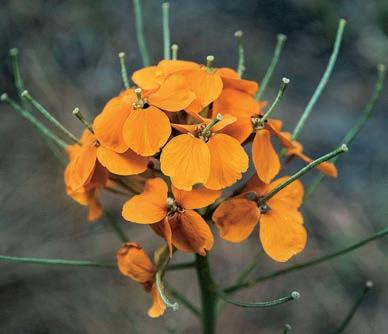
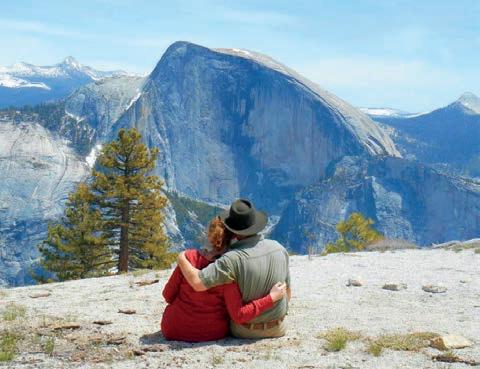
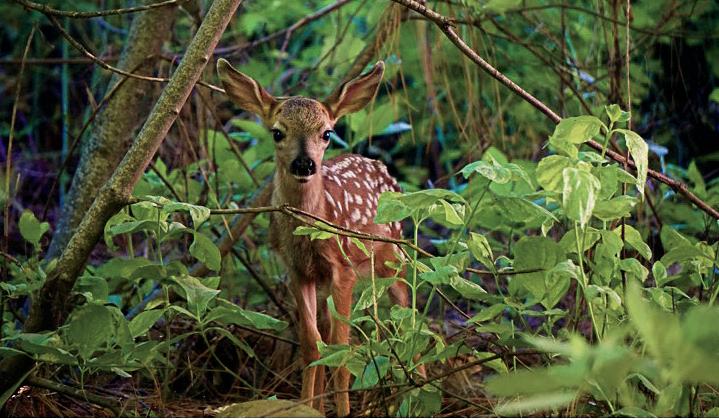
love to see your shots! Share your favorites with us on Flickr, Facebook and Instagram, or email them to
04 03 02 READER PHOTOS 01 Western Juniper. PHOTO BY © MELISSA STELLER. 02 Western Wallflower. PHOTO BY © AVI DRORI. 03 View from North Dome. PHOTO BY © TAYLOR STANTON. 04 Young Deer. PHOTO BY © DANNY KAUFMAN. Show us your Yosemite photos! These images were captured by Yosemite fans
you. We’re
we’d
community@yosemiteconservancy.org. 30 SPRING.SUMMER 2017 :: YOSEMITECONSERVANCY.ORG YOSEMITE’S MAJESTY AS CAPTURED BY OUR SUPPORTERS
01
like
always looking for photos to feature in our social media, enewsletter and magazine — and
YOSEMITE THROUGH YOUR LENS
YOSEMITE CONSERVANCY
Magazine of Yosemite Conservancy, published twice a year.
EDITORIAL DIRECTOR
Jennifer Miller
ASSISTANT EDITORS
Claire F. Meyler & Lauren Hauptman
CONTRIBUTING WRITERS
Frank Dean Gretchen Roecker
Brandon Latham
DESIGN PRINT PRODUCTION
Eric Ball Design TradeMark Graphics, Inc.
STAFF :: San Francisco
Frank Dean, President & CEO
Jerry Edelbrock, Vice President, CFO & COO
Kim Coull, Development Director
Alison Dombroski, Campaign & Development Projects Manager
Edin Draper-Beard, Executive Affairs Manager
Laura Garland, Senior Accountant
Kevin Gay, Finance Director
Debra Holcomb, Planned Giving Director
Sara Jones, Institutional Giving Officer
Holly Kuehn, Development & Donor Services Assistant
Jamie Lilly, Events Director
Isabelle Luebbers, Annual Giving Director
Jennifer Miller, Marketing & Communications Director
Eryn Roberts, Data Services Assistant
Gretchen Roecker, Communications & Social Media Manager
Kiely Smith, Data Assistant
Alexa Ward, Communications & Website Manager
STAFF :: Yosemite
Adonia Ripple, Director of Yosemite Operations
Greg Archer, Valley Sales Supervisor
Carolyn Botell, Theater Coordinator
Nicole Brocchini, Museum Store Supervisor
Kylie Chappell, Outdoor Programs Manager
Pete Devine, Resident Naturalist
Teresa Ellis, Sales Information Assistant
Schuyler Greenleaf, Projects Director
Suzy Hasty, Volunteer Program Manager
Cory Jacobs, Inventory Coordinator
Ryan Kelly, Projects Coordinator
Olotumi Laizer, Valley Complex Supervisor
Katie Manion, Retail Operations Manager
Cassie May, Outreach & Wholesale Coordinator
Mark Scrimenti, Lead Wilderness Reservation Assistant
Shelly Stephens, Inventory Manager
Laurie Stowe, Wilderness Programs Manager
Samantha Welsh, Art Center Coordinator
STAFF :: Pasadena
Patti Johns Eisenberg, Major Gifts Officer
Spring.Summer 2017 :: Volume 08. Issue 01 ©2017
Federal Tax Identification No. 94-3058041
Ways to Give
THERE ARE MANY WAYS you and your organization can support the meaningful work of Yosemite Conservancy. We look forward to exploring these philanthropic opportunities with you.
CONTACT US
Visit yosemiteconservancy.org
Email info@yosemiteconservancy.org
Phone 415-434-1782
INDIVIDUAL GIVING
Development Director
Kim Coull kcoull@yosemiteconservancy.org 415-434-8446 x324
Annual Giving
Isabelle Luebbers iluebbers@yosemiteconservancy.org 415-434-8446 x313
Major Gifts
Patti Johns Eisenberg peisenberg@yosemiteconservancy.org 626-390-1503
FOUNDATIONS & CORPORATIONS
Sara Jones
sjones@yosemiteconservancy.org 415-434-8446 x328
PLANNED GIVING & BEQUESTS
Debra Holcomb dholcomb@yosemiteconservancy.org 415-434-8446 x319
HONOR & MEMORIAL GIFTS
Isabelle Luebbers iluebbers@yosemiteconservancy.org 415-434-8446 x313
Mail
Yosemite Conservancy 101 Montgomery Street, Suite 1700 San Francisco, CA 94104 Fax 415-434-0745
GIFTS OF STOCK
Eryn Roberts stock@yosemiteconservancy.org 415-434-8446 x330
SEQUOIA SOCIETY MONTHLY GIVING
Isabelle Luebbers iluebbers@yosemiteconservancy.org 415-434-8446 x313
MATCHING GIFTS
Isabelle Luebbers iluebbers@yosemiteconservancy.org 415-434-8446 x313
VOLUNTEER OPPORTUNITIES
Suzy Hasty shasty@yosemiteconservancy.org 209-379-2317 yosemiteconservancy.org/volunteer
DONOR GUIDE
YOSEMITECONSERVANCY.ORG :: SPRING.SUMMER 2017 31
Conservancy
101 Montgomery Street, Suite 1700
San Francisco, CA 94104
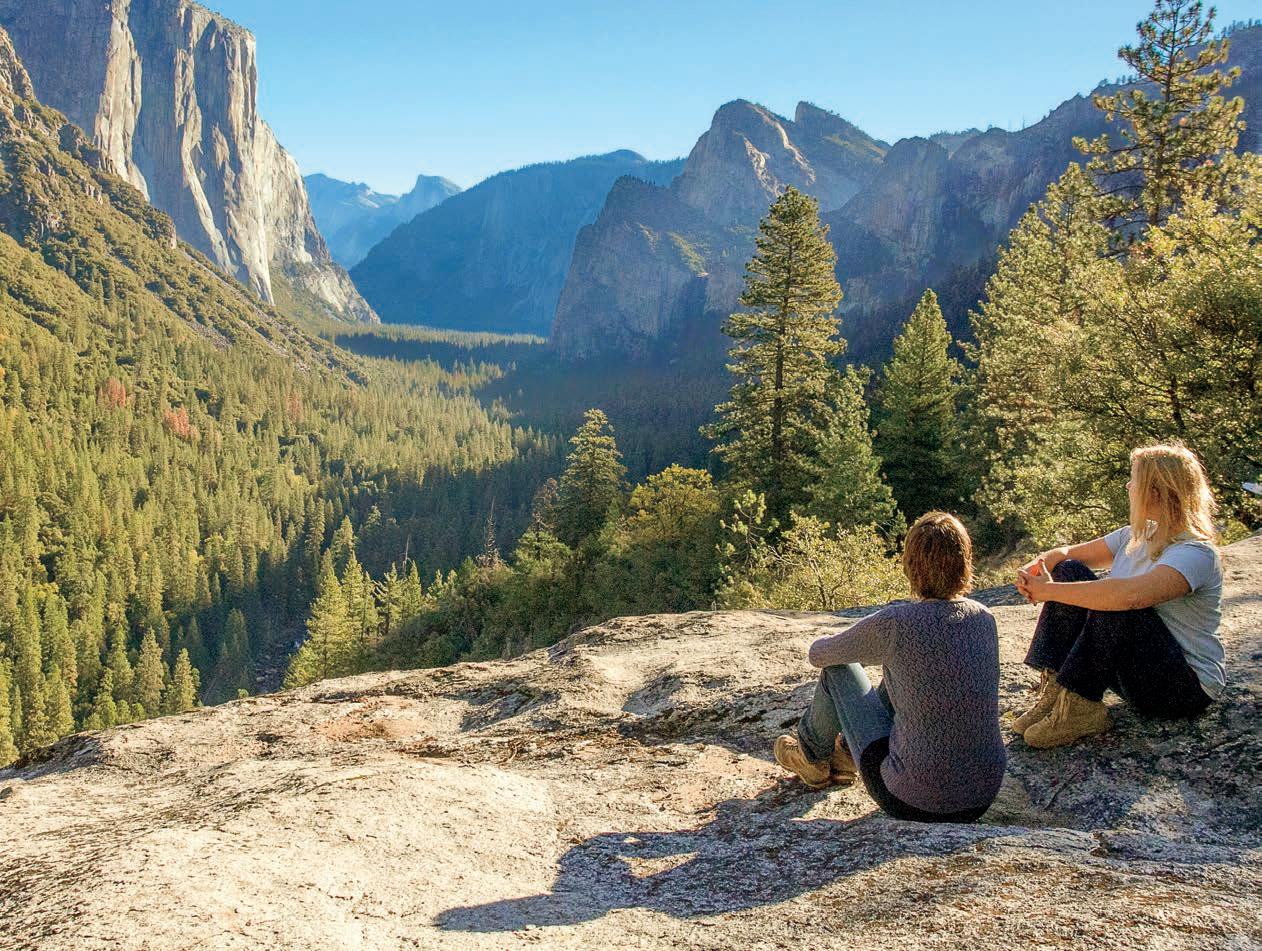
Yosemite’s natural wonders are not only our inheritance, but also our responsibility. Your legacy gift to Yosemite Conservancy makes a lasting impact beyond your lifetime, commemorating your special connection to Yosemite while ensuring the park remains a beloved treasure for future generations to enjoy.
To find out how you can leave your legacy to Yosemite, contact Debra Holcomb at dholcomb@yosemiteconservancy.org or 415-434-8446 x319.
yosemiteconservancy.org/plannedgiving
Yosemite
Follow the Conservancy on social media to stay in touch on the go.
© KEITH WALKLET. Your Yosemite
PHOTO:
Legacy
















 Leaning Tower
Leaning Tower

















































